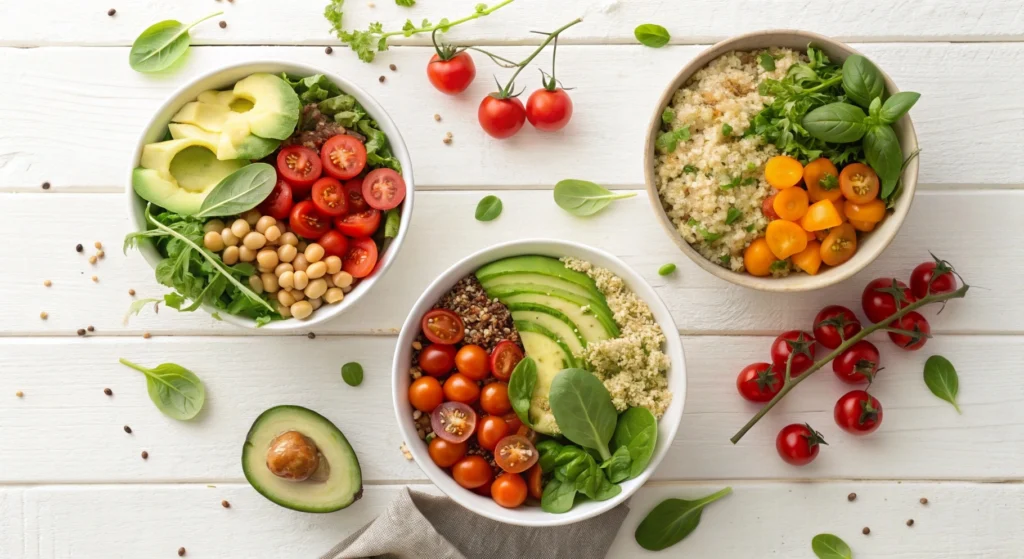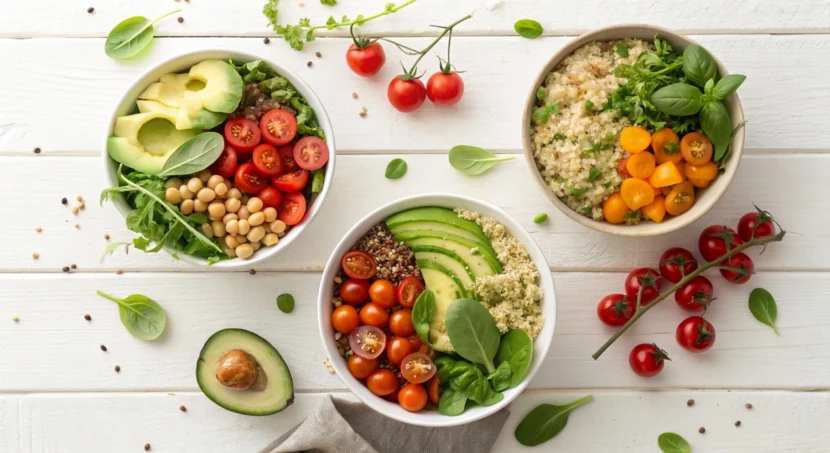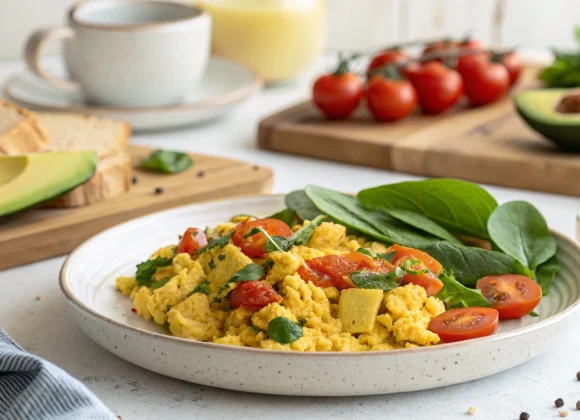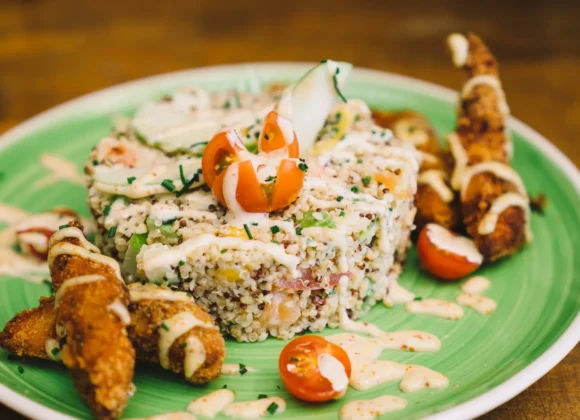Let me guess—you’re standing in your kitchen on Sunday afternoon, staring at a bunch of vegetables like they’re a puzzle you can’t solve. I’ve been there. The whole meal prep thing sounds amazing in theory, but when you’re actually doing it? Total overwhelm. Here’s the thing though: plant-based meal prep bowls don’t have to be complicated. In fact, once you nail the mix-and-match formula, you’ll wonder why you ever stressed about it in the first place.
Table of Contents
Why plant-based meal prep bowls Are Your New Best Friend

Build a base, add some protein, throw in your veggies, and boom—you’ve got plant-based meal prep bowls sorted for days. These easy vegan meal prep strategies make weekday lunches exciting without repeating the same boring meals.
The beauty here? You’re not eating the same boring meal five times. You prep components once, then mix them differently throughout the week. Monday’s Mediterranean bowl becomes Wednesday’s Asian-inspired creation. Same ingredients, totally different vibe. It’s like having a capsule wardrobe, but for food. Perfect for anyone looking for healthy lunch bowls that stay fresh all week.
Plus, plant-based ingredients typically last longer in the fridge than their animal-based cousins. No sketchy chicken situation on day four, you know? 🙂
The Mix-and-Match Formula That Actually Works
Here’s where most people mess up—they try to prep entire meals instead of prepping components. That’s why you end up with soggy, sad lunches by Wednesday. Instead, think modular for weekday meal prep ideas.
The Base Layer
Your base is the foundation, and honestly, variety here keeps things interesting. I usually prep three different bases for plant-based meal prep bowls:
- Quinoa – The overachiever with complete protein
- Brown rice – Reliable, filling, and pairs with literally everything
- Mixed greens – For when you want something lighter (prep these fresh daily though)
Cook your grains in batches on Sunday. Season them differently for variety—lemon and herbs for one, turmeric and garlic for another. FYI, this tiny step makes a massive difference in preventing taste bud boredom.
The Protein Punch
Plant-based protein isn’t just tofu (though I’m absolutely team tofu). Your options are way more exciting:
- Legumes and beans – Chickpeas, black beans, lentils—they’re cheap, filling, and incredibly versatile. Roast chickpeas with smoked paprika and they taste completely different from curry-spiced ones. For more inspiration, check out this 30-Minute Chickpea Sweet Potato Curry for a flavorful option.
- Tofu and tempeh – Press your tofu properly, marinate it overnight if you can, then bake or pan-fry until crispy. Tempeh brings a nutty, fermented goodness perfect for quick plant-based dinners. You can also explore more high-protein plant-based meals for variety.
- Edamame – Lazy person’s protein. Pop it in boiling water for five minutes. Zero effort, maximum nutrition.
Prep two different proteins per week. Any more than that and you’ll spend your entire Sunday in the kitchen, defeating the purpose.
Vegetables: The More, The Merrier
Ever wondered why restaurant bowls look better than homemade ones? It’s all about vegetable variety.
Roasted Veggies – Caramelization is your secret weapon:
- Sweet potatoes (cubed)
- Brussels sprouts (halved)
- Bell peppers (chunked)
- Cauliflower (florets)
- Red onion (wedged)
Toss in olive oil, salt, and pepper. Roast at 425°F for 25–30 minutes. Done. Your healthy lunch bowls now have a flavorful backbone.
Raw Crunch – Add shredded cabbage, sliced cucumber, cherry tomatoes, and grated carrots for texture. Prep separately and mix only when ready to eat.
Quick-Pickle Game – Slice radishes, red onions, or carrots thin, cover with rice vinegar, a pinch of sugar, and salt. Let sit 30 minutes. These tangy gems elevate any plant-based meal prep bowl from “meh” to “chef-level.”e tangy gems elevate any plant-based meal prep bowl from “meh” to “chef-level.”
Sauces and Dressings: Where the Magic Happens

IMO, this is where most plant-based meal prep bowls either fail or succeed. You can have the most perfectly prepped ingredients, but without a killer sauce? You’re basically eating healthy cardboard.
Make at least three different sauces or dressings. Store them in small jars or containers, and suddenly you have endless combinations. These are perfect for anyone looking for easy vegan meal prep ideas that keep lunch exciting.
My Weekly Rotation
- Tahini-Lemon Dressing – Mix tahini, lemon juice, garlic, water until smooth. Works with literally everything.
- Peanut-Ginger Sauce – Peanut butter, rice vinegar, soy sauce, ginger, and a touch of maple syrup. Asian bowls instantly level up.
- Cilantro-Lime Crema – Blend cashews (soaked), lime juice, cilantro, and jalapeño with water until creamy. Mexican-style bowls just got real.
Keep these separate until eating time. No one wants pre-soggy salad greens. Trust me on this one :/
The Assembly Strategy
Here’s where the mix-and-match brilliance really shines. You’ve got your components, now you’re essentially playing Chopped in your own kitchen.
Monday: Mediterranean Vibes
- Quinoa base
- Chickpeas (roasted with cumin)
- Roasted red peppers and cauliflower
- Cherry tomatoes and cucumber
- Tahini-lemon dressing
- Sprinkle of hemp seeds
Wednesday: Asian Fusion
- Brown rice base
- Crispy tofu
- Roasted Brussels sprouts and sweet potato
- Quick-pickled carrots
- Edamame
- Peanut-ginger sauce (30-Minute Chickpea Sweet Potato Curry)
- Sesame seeds
Friday: Mexican-Inspired
- Quinoa base (the turmeric one)
- Black beans
- Roasted bell peppers and red onion
- Fresh cabbage slaw
- Cilantro-lime crema (Seaweed Superfood Smoothie Bowl Recipes)
- Pumpkin seeds
Same ingredients, completely different meals. That’s the beauty of this system—you’re remixing the same playlist all week. These are exactly the type of healthy lunch bowls that make weekday meal prep ideas stress-free.
Storage Hacks That Prevent Disaster

Glass containers are worth the investment. They don’t stain, they don’t hold smells, and they’re microwave-safe. For bowls specifically, I use divided containers. Keep wet ingredients (sauces, pickled veggies) separate from everything else. Greens go in one section, grains in another, and so on.
Label everything with the prep date. Future you will thank present you when you’re not playing the “smell test” game on Thursday morning. Most cooked grains last 4–5 days in the fridge. Roasted vegetables hang in there for about the same. Sauces can last a week if stored properly. If something looks or smells off, toss it.
Toppings That Make You Look Like You Tried
Want your plant-based meal prep bowls to look Instagram-worthy? It’s all about finishing touches:
- Seeds and nuts – Pumpkin seeds, sunflower seeds, almonds, cashews
- Fresh herbs – Cilantro, parsley, green onions
- Microgreens – If you’re feeling extra fancy
- Nutritional yeast – Cheesy flavor without dairy
- Hot sauce – Because sometimes you need that kick
Keep these in your desk or bag if taking lunch to work. Sprinkle them on right before eating. This tiny step makes day-old meal prep taste fresh.
Time-Saving Shortcuts Nobody Talks About
Some shortcuts are worth it. Pre-cut frozen vegetables cook just as nicely as fresh ones. Frozen edamame? Already shelled. Canned beans instead of dried? Totally valid—rinse well and you’re good.
Batch cook on alternating weeks. Make a huge batch of grains one Sunday, freeze half. Next week, grains are already ready. Same with sauces—double the recipe, freeze in ice cube trays, and pop them out as needed. Some grocery stores sell pre-cooked quinoa or brown rice in pouches. If your budget and schedule allow, go for it. The best quick plant-based dinners are the ones you’ll actually make.
Making It Work with Your Actual Life
Here’s the truth bomb: you don’t need to prep five days of meals every Sunday. Start with three days. Get comfortable with that rhythm before scaling up.
Pick one day when you actually have time. Maybe Sunday doesn’t work for you—prep on Wednesday evening instead. The meal prep police aren’t coming to arrest you for doing things differently.
Get your family or roommates involved. Someone chops while someone else cooks grains. Put on music or a podcast. Make it less of a chore and more of a hangout session where food happens to get made.
And look, some weeks you’ll nail it. Other weeks you’ll end up buying lunch three days in a row because life happened. That’s completely fine. Progress over perfection, always.
Mix & Match Plant-Based Meal Prep Bowls for Busy Weekdays
The Bottom Line
Plant-based meal prep bowls aren’t about restriction or forcing yourself to eat boring food all week. They’re about giving yourself options when you’re too tired to think, too busy to cook, or too hungry to make good decisions.
The mix-and-match approach means you’re never locked into one flavor profile. You’ve got variety without the stress. You’re eating well without spending an hour every evening in the kitchen. And honestly? Once you get the hang of it, the whole process takes maybe two hours on a Sunday.
So grab those containers, pick your components, and start building your bowl empire. Your weekday self is going to be ridiculously grateful. And who knows—you might actually start looking forward to lunch again.




